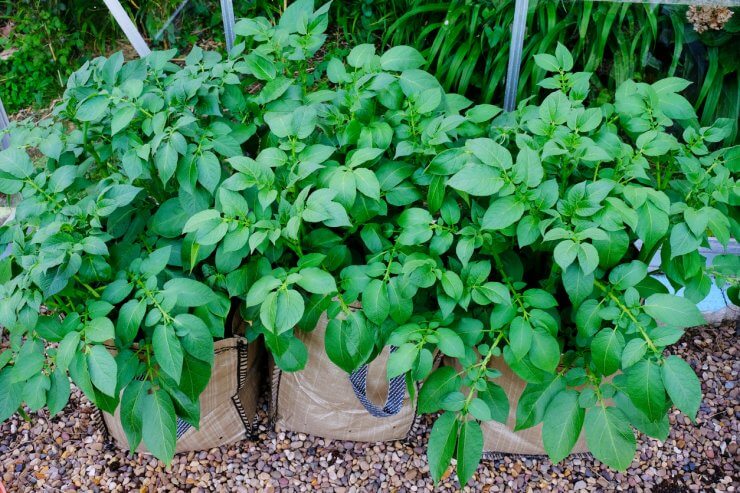
The decision to learn how to grow potatoes in a bag is not one to be taken lightly. Are you short on garden space but still want a crop of universally delicious starch bombs? Or maybe you like science experiments. You probably fall somewhere between Mr. Wizard and Bill Nye in age and have always been drawn to DIY science like crystal-growing, rock-tumbling, and figuring out which dish soap makes the best bubble solution. (spoiler alert: use glycerin!) No matter the reason, the time has come for you to learn the magical art of how to grow potatoes in a bag. With this knowledge comes great responsibility. Read on if you dare.
Depending on the variety and your growing zone, you can plant potatoes in early to late spring. There are three main categories of potatoes you can grow in your grow bag:
- First early: These spuds will be ready for harvest in about 10 weeks
- Second early: These potatoes will be ready for harvest in about 13 weeks
- Maincrop: These are usually the big guys used for baking and mashing and are ready for harvest in about 20 weeks
The great news about learning how to grow potatoes in a bag is that you can plant any category of potato and yield a healthy crop. You can learn everything you need to know about growing potatoes in our Potato Collection. I recommend using seed potatoes to start your potato crop. These are potatoes grown specifically to be used for growing and won’t have as many chemicals and even potential germs that store-bought potatoes will have. I like to sprout my seed potatoes before I plant them. This can be done easily by placing them in a cool, light-filled room.
What kind of bag do you need?
There’s a lot of options out there when learning how to grow potatoes in a bag. You can buy specially designed potato grow bags at your garden store or online. They come in various materials like fabric and heavy plastic and are relatively inexpensive. I’ve also seen folks re-purpose thick, reusable grocery bags and even big blue Ikea shopping bags. Burlap sacks can be used for potato growing. If you’re in a bind you can even use a medium-sized garbage bag, though you’ll only be able to use it for one season.
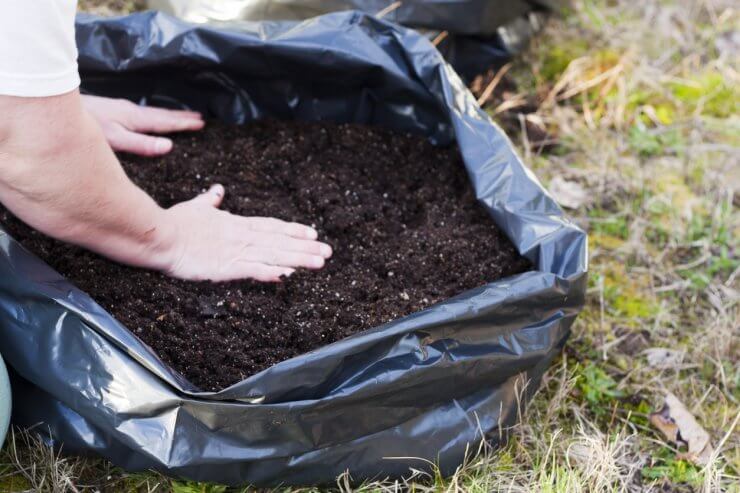
Preparing your bag
If you go the plastic bag route, place a few holes at the bottom of the bag for drainage. Fabric and mesh materials will have natural drainage abilities. Place a few inches of potting soil in the base of the bag. If you have other container gardens, you can use the same potting mix. If you want to use fertilizer or compost, add that now and mix thoroughly.
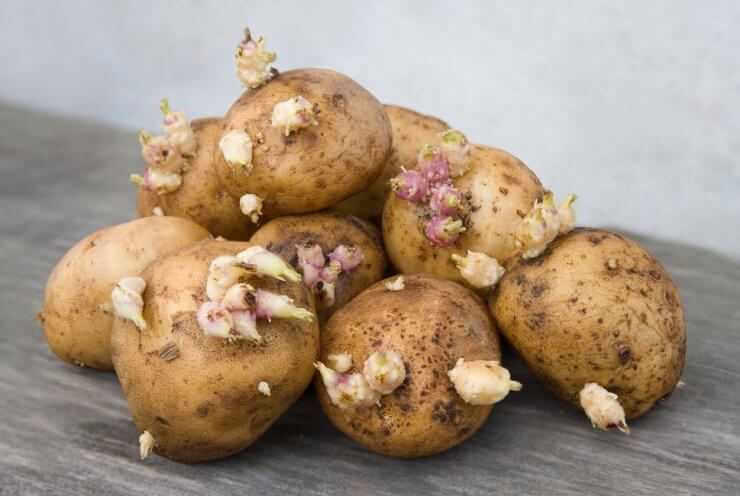
Plant the seed potatoes
The trick is to avoid overcrowding. Depending on your bag size, place three or four potato seed pieces in the soil and cover them with another few inches of soil. Water your bag well and make sure it drains properly.
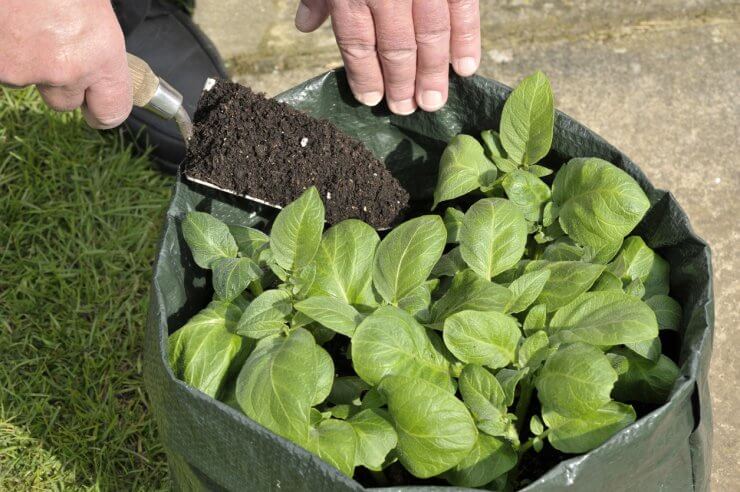
Now what?
Place the bag in an area where it can receive full sunlight, at least 6 hours each day. Try to avoid putting the bag on a surface that will get too hot like concrete or asphalt since that will damage the plants. After your potato plants grow about eight to ten inches, add another few inches of soil. Water thoroughly. You’ll want to keep doing this when the stems grow to be about eight to ten inches above the soil line. Repeat this until the bag is topped off. Alternatively, you can use hay or thick mulch instead of soil. Once your grow bag is full just continue to water regularly.
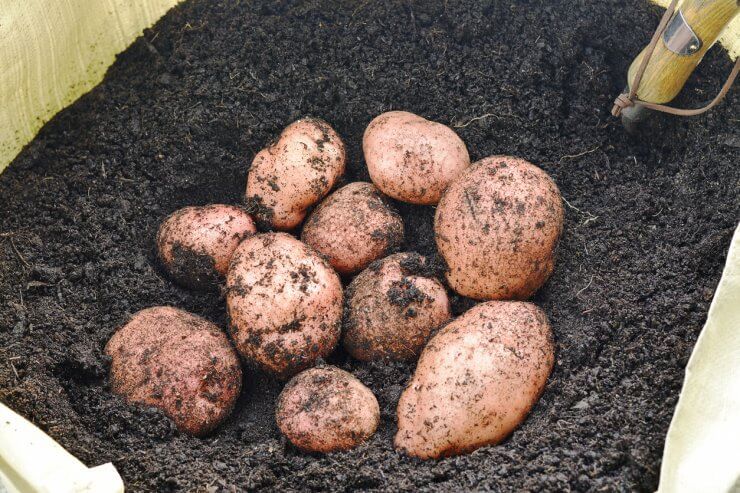
When should you harvest?
Whether you’re learning how to grow potatoes in a bag or growing them in your yard, a good indication for when to harvest is when the plant turns yellow. Some varieties will flower, as well. If you planted smaller potatoes you can gently prod the soil and pull them up, but for bigger varieties, you can just dump the bag out once the plant has matured.
Once you learn how to grow potatoes in a bag, you can experiment with other tubers and even other vegetables and fruits. I love using grow bags for blueberry bushes so I can move them around more easily in my yard. Grow bags are a great garden tool especially for folks who want to avoid kneeling in their garden. Grow bags make gardening more accessible for people with mobility issues as well as people who might be renting and don’t have access to garden space.
Want to learn more about growing potatoes at home?
Potatoes and sweet potatoes have been around for thousands of years, and they’re a main staple in many cultures. Both of these vegetables are easy to grow at home. With the How to Grow Potatoes premium collection, you’ll learn all you need to know about growing and enjoying these fabulous root vegetables. From the history and background to specific advice about soil requirements and fertilizer … from easy-to-make and delicious recipes so you can enjoy the fruits of your gardening labor to the nutritional and health benefits of potatoes and sweet potatoes—get it all in our How to Grow Potatoes guide.
Do you already know how to grow potatoes in a bag? What tips do you have? What else have you grown in a bag? Let me know in the comments!


 Previous
Previous


I’d like to try growing potatoes in a bag indoors – Zone 5, so we’re getting frosts already. The potatoes have already sprouted and are begging for soil. My room is a glassed in porch, and there is a light – I use a bar heater to keep the temperature around 15 C – much warmer on sunny days. Any chance it will work?
Potatoes thrive when daytime temps are between 20-25C (65-80F) so you may want to crank up your heater on those cloudy days. Keep hilling (adding soil to your bag) until the bag is nearly full. Good luck and let us know how it turns out.
My potatoes were growing beautifully in bags for my first fry. Then hail stripped the plants! I’m leaving them alone hoping there is still time for them to come back. I’m also growing bush pasta squash and they are doing well with little hail damage as they were protected by our fence and neighbor’s tree. Has been an unusually wet season in Denver!
Can potatoes be safely grown in bags near Blueberry plants? I’m aware of the caution given if they are planted in the ground near them.
I don’t see why not, they just require very different soil, so the bags should take care of that issue.
Can you plant an actual potato for getting more potato’s to harvest snd have to eat ?
Yes! I like to try new varieties, often not available except from other people. If the potatoes have sprouted, it should be okay. GRocery store potatoes that are not sprouted may have had a sprout inhibiter applied, and would not grow or at least as well. I have particularly liked fingerlings that I have been given, and an unnamed one that an old German neighbour had brought from there and continued to propagate for many years.
What is a safe pesticide for vegetables
Thank You for the DIY on Soil testing, but I have a question, I cleared a piece of lot, where My dad use to burn scrap metal, and pour out battery acid, my dad passed away 27 years ago, so would this land be contaminated to grow vegetables, and fruits.
Yes, I am sure that the ground is poison
SHOULD YOU PINCH OFF THE FLOWERS ON POTATOE PLANTS?
Yes! If they start early, pinch them off so they can focus on growing the potatoes. If it’s around time to harvest, the flowers usually mean they’re mature.
Can you grow mint with your flowers in a large flower pot
Yes! In fact that’s how many people stop them from spreading 🙂